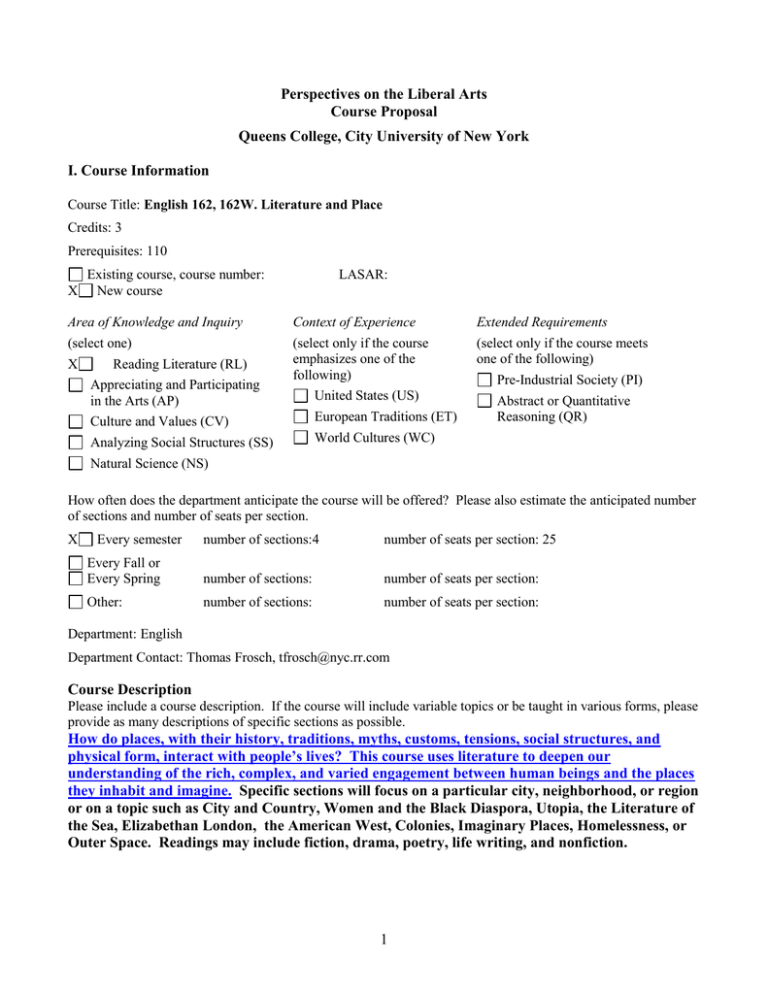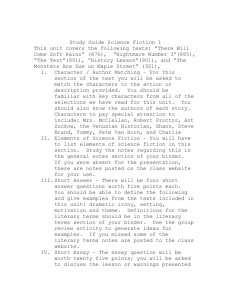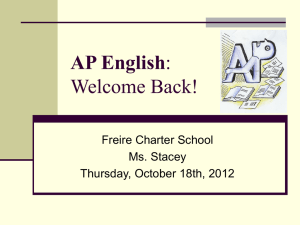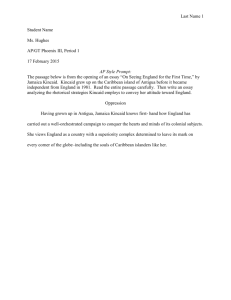Perspectives on the Liberal Arts Course Proposal
advertisement

Perspectives on the Liberal Arts Course Proposal Queens College, City University of New York I. Course Information Course Title: English 162, 162W. Literature and Place Credits: 3 Prerequisites: 110 X Existing course, course number: New course LASAR: Area of Knowledge and Inquiry Context of Experience Extended Requirements (select one) (select only if the course emphasizes one of the following) (select only if the course meets one of the following) X Reading Literature (RL) Appreciating and Participating in the Arts (AP) Culture and Values (CV) Analyzing Social Structures (SS) United States (US) European Traditions (ET) Pre-Industrial Society (PI) Abstract or Quantitative Reasoning (QR) World Cultures (WC) Natural Science (NS) How often does the department anticipate the course will be offered? Please also estimate the anticipated number of sections and number of seats per section. X Every semester number of sections:4 number of seats per section: 25 Every Fall or Every Spring number of sections: number of seats per section: Other: number of sections: number of seats per section: Department: English Department Contact: Thomas Frosch, tfrosch@nyc.rr.com Course Description Please include a course description. If the course will include variable topics or be taught in various forms, please provide as many descriptions of specific sections as possible. How do places, with their history, traditions, myths, customs, tensions, social structures, and physical form, interact with people’s lives? This course uses literature to deepen our understanding of the rich, complex, and varied engagement between human beings and the places they inhabit and imagine. Specific sections will focus on a particular city, neighborhood, or region or on a topic such as City and Country, Women and the Black Diaspora, Utopia, the Literature of the Sea, Elizabethan London, the American West, Colonies, Imaginary Places, Homelessness, or Outer Space. Readings may include fiction, drama, poetry, life writing, and nonfiction. 1 II. Criteria for Perspectives Courses Justification Please describe how the course will address criteria for Perspectives on the Liberal Arts courses. Be sure to include an explanation of the course’s specific learning goals for students to make a connection between these and the general criteria for Perspectives courses. In studying the various roles place can have in a literary work when it becomes more than setting, 162 introduces students to the reading and analysis of literature. It teaches the basic techniques of close reading, explication, and writing about literary texts, and it introduces students to different critical methods and perspectives. It helps students understand and appreciate the special kinds of knowledge or consciousness that literature provides, the complexities and resonances of literary language, and the various ways in which texts may interact with other texts and with cultural, historical, and geographical realities. It shows how literature exposes us to experiences and perspectives other than our own because of differences of time, place, race, class, and gender, and how literature may also show us our own experience and place from other perspectives. How do places, with their history, traditions, myths, customs, tensions, social structures, and physical form, shape people’s lives? What does it mean to have a home or not to have a home? What does it mean to change places, either voluntarily or involuntarily? How do different people experience the same place differently? How do places change over time, and how do they remain constant? How do certain places assume a mythic status? How do places develop their own cultures? Why do we need to invent non-existent places or think about places that are not and may never be part of our experience? In asking such questions through literary works, the course brings the resources of literature to bear on a topic with which everyone can identify and which is part of everyone’s experience and thinking. To the perspectives on place that may be offered by historical, sociological, urban studies, anthropological, and other viewpoints, this course adds the consideration of how we represent place and our relationship to it in literary form. It uses the literature to deepen the students’ appreciation of the rich, complex, and varied engagement between human beings and the places they inhabit and imagine. The course studies how writers of diverse sensibility and background experience and represent a place. A particular question that it asks is how the mediating presence of place produces different responses to that place conditioned upon the writers’ differences in race, gender, sexuality, ethnicity, class, and historical and cultural moment. Even sections that limit the scope of the material to a given historical period would demonstrate the changes that occur in the specific time period in the development of literary form and content, in historical and political changes, in changes in cultural mood, and in the sense that any cultural moment represents a change from a previous moment or era. Sections of the course with larger frames of reference are, in fact, about change, as the place itself undergoes transformation. Part of the subject matter of the course is the examination of the writer as he or she confronts the transformation of a native or adoptive home. 162 engages students in active inquiry by requiring of them extensive analytical, interpretive, and, in many cases, research writing, as well as by involving them in extensive class discussion. As in any literature course, students will be studying primary literary texts. 2 Criteria Checklist Please be sure that your justification addresses all three criteria 1-3, below. For criteria 4-8, please check all that apply and discuss these in your justification. A Perspectives course must: In addition, a Perspectives course will, where appropriate to its discipline(s) and subject matter: 1. Be designed to introduce students to how a particular discipline creates knowledge and understanding. 4. Be global or comparative in approach. X 5. Consider diversity and the nature and construction of forms of difference. 2. Position the discipline(s) within the liberal arts and the larger society. X 3. Address the goals defined for the particular Area(s) of Knowledge the course is designed to fulfill. 6. Engage students in active inquiry. X 7. Reveal the existence and importance of change over time. X 3 8. Use primary documents and materials. III. Course Materials, Assignments, and Activities Please provide an annotated list of course readings and descriptions of major assignments or exams for the course, as well as distinctive student activities that will engage students in working toward the course goals discussed in the course description and/or justification. Please include the author and title for each reading or text, along with a short description providing information about how the reading will contribute to course goals Sections will use different topics and texts, but all sections will address the general issues of literature, place, and the liberal arts discussed in the Justification above. See sample syllabi below. IV. Assessment Perspectives courses must be recertified every five years, and we are seeking ideas for how to best carry out this assessment. What forms of evidence that the course is meeting its goals as a Perspectives course would be appropriate to collect for this course during the next five years? How would you prefer assessment to be conducted? How might evidence of effective teaching and student learning be collected and evaluated? The Department will collect and submit syllabi and will also design questionnaires for both instructors and students to evaluate the course. V.Administration What process will your department develop to oversee this course, suggest and approve changes, and conduct assessment? Who will be in charge of this process? The PLAS English courses and their assessment will be administered by the Chair or her designee, most likely either the Curriculum Committee or the Director of Undergraduate Studies (Associate Chair). The Chair or her designee will collect syllabi to make sure that the PLAS criteria are being fulfilled and to maintain a file that other instructors can consult. The Chair or her designee will meet with part-timers assigned to PLAS courses in advance of their teaching the courses to make sure they understand the PLAS criteria and to help them develop syllabi. Any changes in the course, like curricular changes in general, would be proposed by the Curriculum Committee and voted on by the Department. VI. Syllabus: We attach two sample syllabi. Please attach a sample syllabus (or set of syllabi, for courses on variable topics or courses that will be taught in variable formats). Some resources to guide syllabus construction: The Provost's page outlining guidelines for syllabi: http://qcpages.qc.cuny.edu/provost/Cur_stud/Syllabus expectations.htm Sample syllabi for W courses, from Writing Across the Curriculum: http://qcpages.qc.cuny.edu/writing/wsyllabi.htm Goals for Student Writing at Queens College: http://qcpages.qc.cuny.edu/writing/Goals.htm Harvard’s Bok Center for Teaching and Learning, suggestions for syllabus planning: http://isites.harvard.edu/icb/icb.do?keyword=k1985&pageid=icb.page29695 Lehman College’s Gen Ed Syllabi Project: http://www.lehman.edu/lehman/programs/generaledu/gened_syllabi_project.html 4 I. Eric B. Song English 162. Literature and Place: The Country and the City How do places, with their history, traditions, myths, customs, tensions, social structures, and physical form, interact with people’s lives? This course uses literature to deepen our understanding of the rich, complex, and varied engagement between human beings and the places they inhabit and imagine. In this section we will approach the topic of literature and place through an exploration of two great categories of place that are, in various ways, the subject of study in a number of disciplines in the liberal arts: the country and the city. We will examine how British (primarily English) literature across a wide range of periods has imagined rural and urban spaces and, more generally, discuss how literary works have formed, represented, challenged, reinforced, and altered historical senses of place. This course demands a balance between close analyses of individual texts and an understanding of how broader extra-literary trends relate to the production of literature. Our syllabus is structured chronologically so that we can trace how depictions of the rural and the urban changed drastically in light of phenomena such as the shift from feudalism to agrarian capitalism and the rise of the industrial metropolis. Assignments Each student will prepare and lead one in-class presentation during the course of the semester. Presentations should introduce some cultural/historical dynamic that sheds light upon our reading for the week. (Students may wish to present on political events, intellectual developments, artistic trends, etc.) Each presentation should be thoroughly researched, last about fifteen to twenty minutes, and transition into a class discussion. Each student will complete two shorter (four-to-five page) essays and one longer (eight-to-ten page) essay. Essay prompts will be provided for the first two essays, but students will be encouraged to pursue their own ideas in consultation with the instructor. For the final essay, students will develop their own arguments about literary representations of the country and the city across different time periods. Course Schedule Unit I: Toward the Modern City from a Feudal Landscape Week 1: Beowulf Week 2: brief selections from Philip Sidney’s Arcadia; country house poetry by Aemilia Lanyer, Ben Jonson, Robert Herrick, Andrew Marvell Week 3: William Shakespeare’s A Midsummer Night’s Dream Week 4: Ben Jonson’s Bartholomew Fair Unit II: Week 5: Week 6: London’s Burning from Samuel Pepys’s Diary William Hogarth, A Rake’s Progress and A Harlot’s Progress; William Blake’s Songs of Innocence and Experience Essay #1 Due Week 7: from William Wordsworth and Samuel Taylor Coleridge’s Lyrical Ballads; select poems by Robert Burns Week 8: from Joseph Addison and Richard Steele’s The Spectator 5 Unit III: The Country & the City in Two Victorian Novels Weeks 9-10: Charles Dickens’s Great Expectations Weeks 11-12: Thomas Hardy’s The Return of the Native Essay #2 Due Unit IV: The 20th-Century Metropolis Week 13 James Joyce’s The Dubliners Week 14: T.S. Eliot, The Waste Land Week 15: Sunrise: A Song Of Two Humans (film) Essay #3 Due In addition to the three essays and the oral presentation, the course will include an essay exam and attention to writing in class discussion, following the Writing Intensive criteria. 6 II. Shirley Carrie-Hartman English 162. Literature and Place: Women in the Black Diaspora How do places, with their history, traditions, myths, customs, tensions, social structures, and physical form, interact with people’s lives? This course uses literature to deepen our understanding of the rich, complex, and varied engagement between human beings and the places they inhabit and imagine. In this section we will approach the topic of literature and place through an exploration of the works of women writers and film-makers across the Diaspora to understand the relationship between gender and the politics of location and dislocation. We will study the impact of place on issues of identity, culture, tradition and nationalism as they pertain to women in Africa, the Caribbean, and the United States. In so doing, we will be discussing the contribution of literary and cinematic narrative to issues taken up in various ways by a number of disciplines in the liberal arts, such as history, sociology, political science, and psychology. Justification: In this class students engage in active inquiry through class discussion and writing about literature and films created by black female artists across the Diaspora. Covering works from different regions, the course is comparative in scope, and the consideration of the nature and construction of forms of difference, of race and gender as well as of culture and geography, is essential to its purpose. In its extensive and detailed close readings of literary works and its development of concepts based on those works, it introduces students to the reading and analysis of literature and to the way evidence is construed and knowledge formulated in the discipline. Sample Readings (Senegal) Mariama Bâ.,.So Long a Letter. A novel originally written in French The novel takes the form of a long letter written by a widow, Ramatoulaye, to her friend, over the mandatory forty-day mourning period following the death of her husband. So Long a Letter is an effective tool for “deconstructing the perceived categorical opposition between tradition and modernity. It pulls students into a world that resists easy categorization, and it adds a female voice to the all too male-centered corpus of historical knowledge and anthropological texts on Africa. Students will be forced to think deeply on issues of cultural change, the West’s construction of Africa, and the relationship between gender and cultural identity. (Zimbabwe) Titsi Dangarembga, Nervous Conditions. A novel written from the perspective of a young girl coming of age in late colonial “Rhodesia.” Nervous Conditions lays out a variety of topics, by following the young protagonist Tambu, through her struggles to gain an education that will allow her to escape her family’s impoverishment. The text invites students to locate more effective ways to grasp the “complexities of gender, generation, and Westernization in a mid-twentieth-century African culture.” (Antigua) Jamaica Kincaid, Lucy The novel is written from the perspective of a 19-year-old West Indian who sheds her cloistered colonial upbringing by accepting a job as an au pair in New York. The protagonist finds being born "woman" places her in a territory she wants to explore and at the same time 7 escape. Kincaid’s novel offers students a gendered understanding of Caribbean history and culture. (Antigua) Jamaica Kincaid, A Small Place Jamaica Kincaid examines the geography and history of her native country, Antigua in this work of nonfiction. She writes about her experiences in Antigua under English colonial rule, memories which instilled in her the need to speak about the world from the perspective of the colonized. Text serves as an effective extra-literary introduction to some of the issues that will inform our primary readings. (United States) Toni Morrison, The Bluest Eye The novel focuses on the experiences of a young black girl growing up in Lorain, Ohio named Pecola who prays for her eyes to turn blue so that she will be as beautiful as beloved as all the blond, blue-eyed children in America. Students will examine the constructions of racialized and gendered identities in American culture. (United States) Alice Walker, The Color Purple In her award-winning novel The Color Purple, Alice Walker tells the story of Celie, a young black girl growing up in the reconstruction South of the United States. In a series of letters to God and to her sister Nettie, Celie tells the story of her life, ranging from the trauma of sexual abuse as a child to her success and wealth as an adult. Text offers students an important cultural framework for understanding gender relations in the early to mid-20th century in the United States. Film (Jamaica) Stephanie Black, Life and Debt (2000) Utilizing excerpts from the award-winning non-fiction text "A Small Place" (which the students will also be reading) by Jamaica Kincaid, Life & Debt is a tapestry of sequences focusing on the stories of individual Jamaicans whose strategies for survival and parameters of day-to-day existence are determined by the U.S. and other foreign economic agendas. Students will be asked to consider how the film engages the post-colonial landscape outlined in Jamaica Kincaid’s text. Assignments and Activities The following are some of the writing assignments to be used in the course. Journals (Informal Writing) To contribute to the goal of engaging students in active inquiry, they will be required to keep a journal for the duration of the semester. In the journal students will reflect on their own experiences of place, especially in relation to race, culture, and gender, in conjunction with the experiences and perspectives they encounter in the readings and thus increase their appreciation of both their own lives and the lives of others. Sources: Any and all course reading plus daily experience of students. Other Assignment Goals To get students intensively and personally involved in primary documents and materials. 8 To get students to generate a body of material that will inform more formal writing assignments. To emphasize practice in reading and the analysis of meaning.. To increase writing fluency by getting students to write informally and regularly. Paper # 1 (Comparison /Contrast) Students will be asked to compare and contrast the treatment of “tradition vs. progress” in the experience of place in Tsitsi Dangarembga’s Nervous Conditions and Jamaica Kincaid’s Lucy. Sources: Novels: Nervous Conditions, and Lucy Assignment Goals To get students, through close reading, to highlight each text’s individual characteristics. To get students, through building ideas on the foundation of close reading, to identify similar or contrasting themes and use these to form a central thes. To get students to learn to write about and compare methods, themes, and symbols in stories. To think in global and comparative terms by bringing together a Caribbean work and an African work. To consider diversity and the nature and construction of forms of difference in the intensive analysis of two novels considered together. To make use of primary documents to explore how values and choices are expressed through literature. Paper # 2 (Research) Students will be asked write a research paper on one or more author’s use of colonial and historical background materials in the representation of place. This paper will be written in stages, with feedback along the way, following the criteria of Writing Intensive courses. Sources: Any and all course reading + secondary reading. Assignment Goals To advance students’ sense of how evidence is construed and meaning developed in literary study by adding a consideration of secondary, critical sources to the consideration of primary sources. To advance students’ sense of how evidence is construed and meaning developed in literary study by adding a consideration of historical and cultural background and the issue of change over time to a consideration of the primary text. To help students appreciate the relations of time to place. To show how historical background material contributes to our sense of the nature and construction of forms of difference. To advance students’ abilities of active inquiry by getting them to come up with a specific research topic on their own, after the more closely guided first paper.. To get students to examine and write about differing critical opinions with regards to their research topics and thus to see how forms of difference reside not only in primary texts but also in the reception of those texts. The course will also include an essay exam, as well as attention to writing issues in class discussion. 9 10






